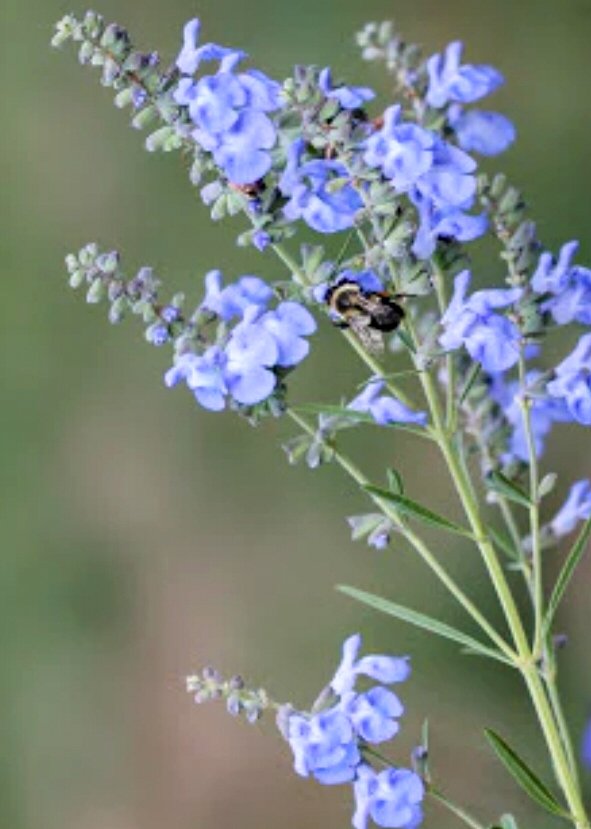 Image 1 of 6
Image 1 of 6

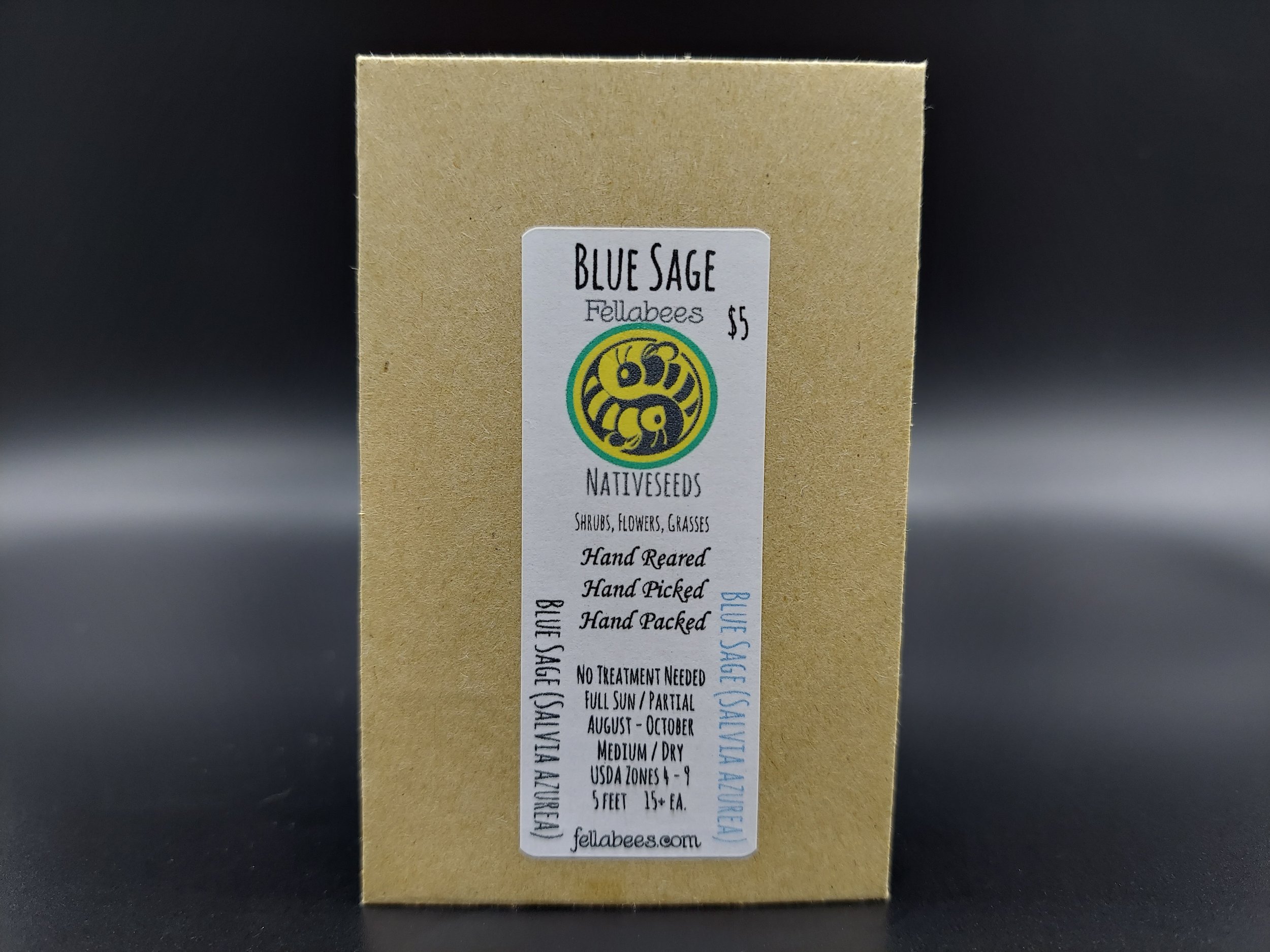 Image 2 of 6
Image 2 of 6

 Image 3 of 6
Image 3 of 6

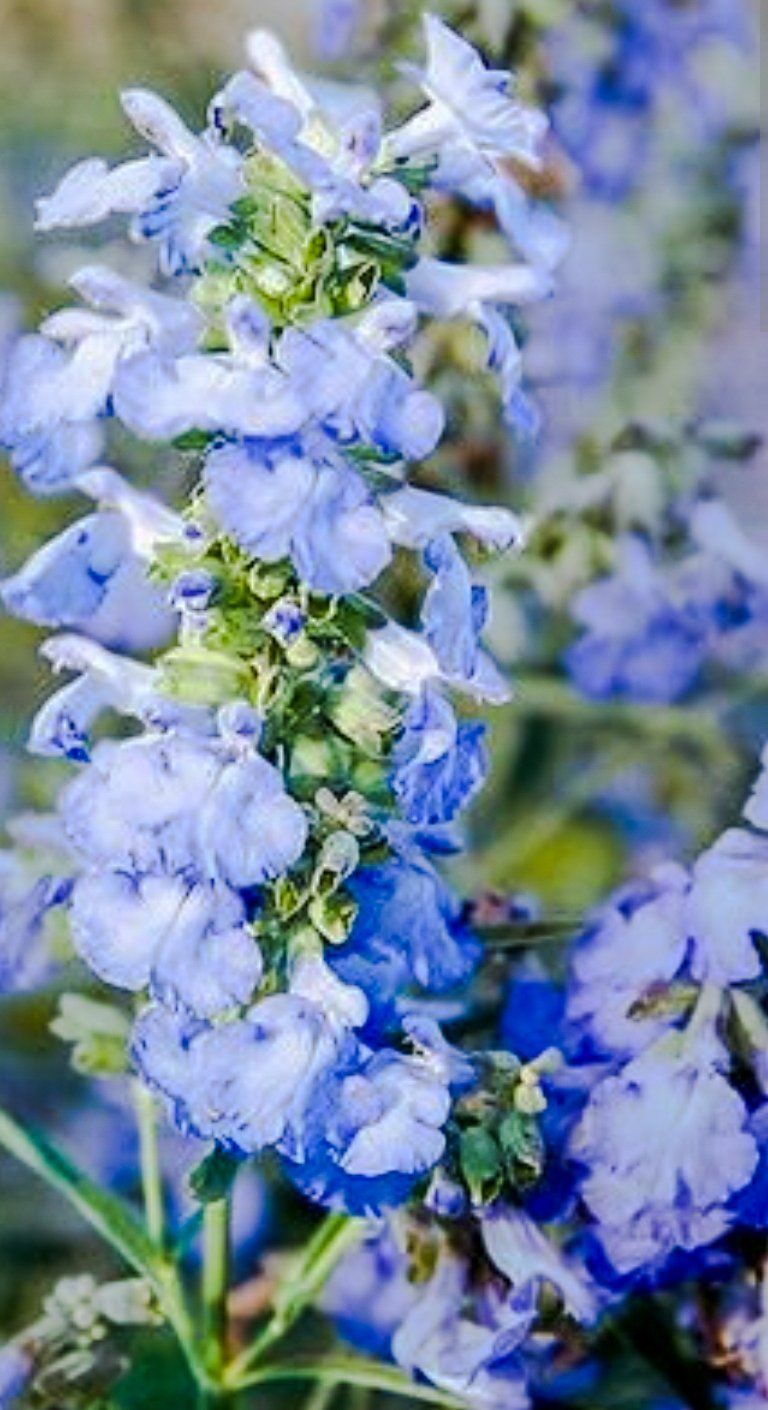 Image 4 of 6
Image 4 of 6

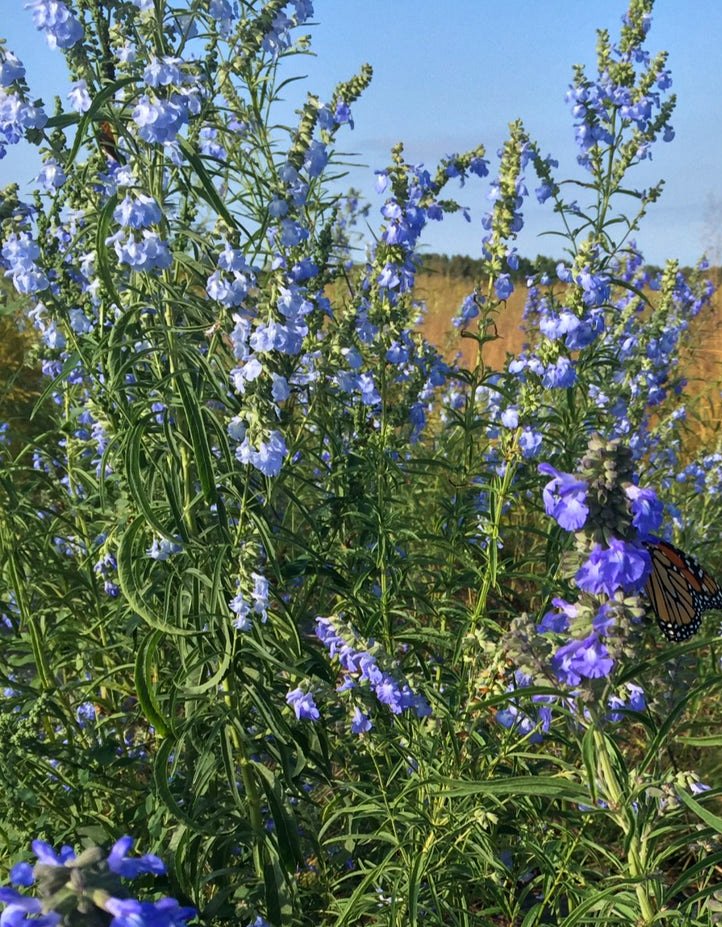 Image 5 of 6
Image 5 of 6

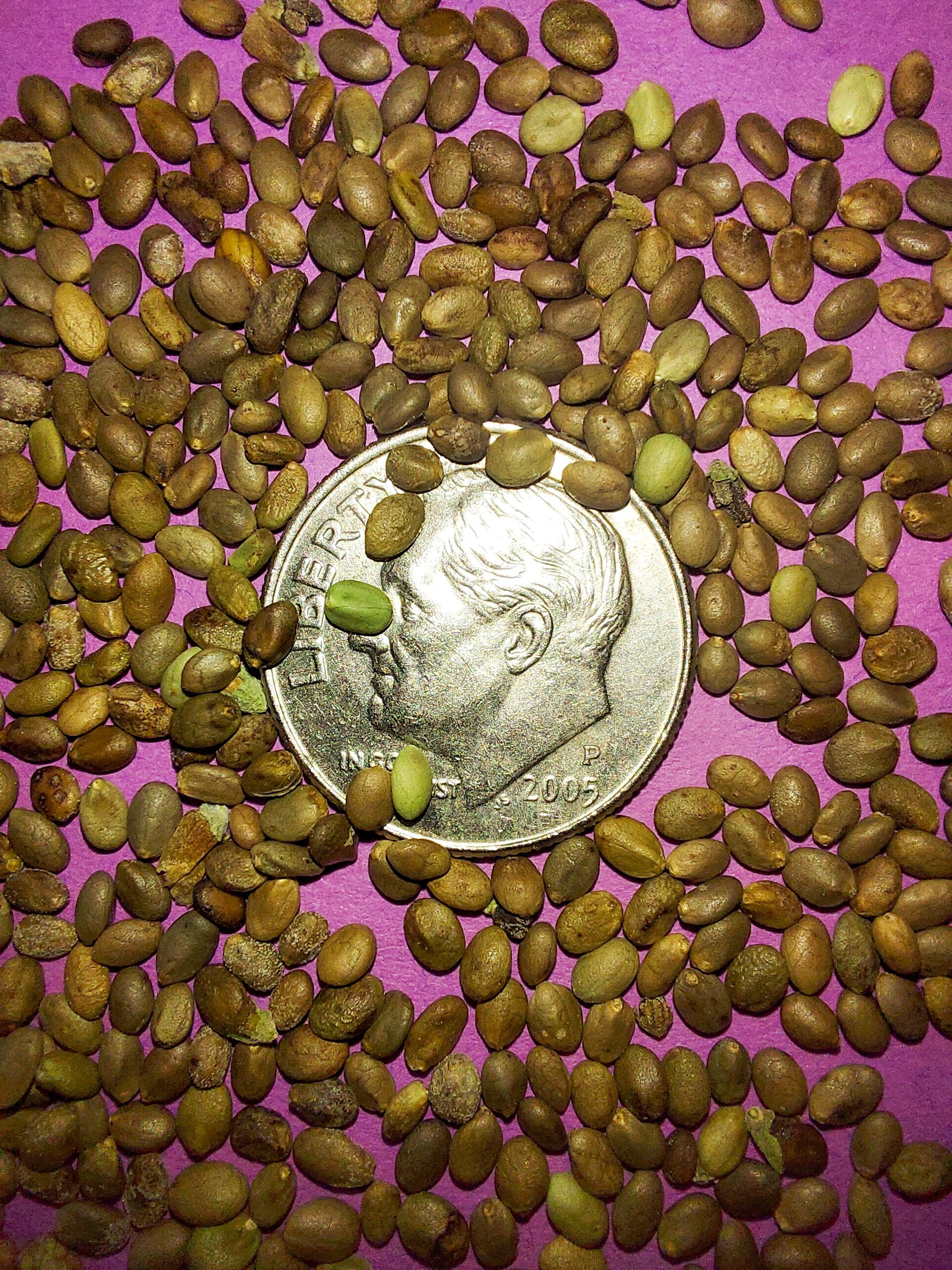 Image 6 of 6
Image 6 of 6







Blue Sage (Salvia azurea)
Blue Sage (Salvia azurea)
Salvia azurea, is the scientific name the native plant more commonly known as Blue Sage, Azure Sage, Azure Blue Sage or Prairie Sage, is a herbaceous perennial hailing from the genus Salvia and found in much of Central and Eastern North America.
Blue Sage is found from Utah east to Connecticut and from Wisconsin south to Florida. In some states within its native range, it has become especially rare, such as in Illinois, where it is listed as a threatened species. This plant is also listed as present but rare in several counties of the states of South Dakota and North Carolina
Its thin, upright stems can grow up to 6 feet tall, with narrow, pointed, smooth-edged to serrated, furry to smooth green leaves, connected to their stems by petioles to 0.4 inches long.
The blue flowers ( but also more rarely white), are nearly 1⁄4 to 1⁄2 inch long, appearing from summer to autumn near the ends of their branched or unbranched spikes; their calyxes are tubular or bell-shaped and furry.
Throughout its native range, it is found growing wild on roadsides, glades, prairies, savannas, fields and pastures. As it’s habitat may indicate, Blue Sage prefers dry, sunny conditions in a variety of soils, including clay, gravel, and loam. In wetter or richer conditions, the plant will still grow and bloom, but tends to flop without supporting grasses growing within its immediate vicinity.
As with most plants in the Sage amd Mint families, this plant is nearly deer and rabbit proof, making it as ideal border plant to surround preferred edible plants, or crops!
When in bloom Blue Sage is typically thronged with pollinators, from Bumblebees to sweat, mason, and mining bees, to many moths, butterflies and even hummingbirds who can be found fighting over newly opened blooms in search of fresh nectar!
Blue Sage is one of the host plants for the enigmatic Hermit Sphinx Moth (Lintneria eremitus)!
Plant Details
USDA Zones: 4-9
Germination Needs: No special treatment needed
Life Cycle: Perennial
Sun Exposure: Full to Partial
Soil Moisture: Medium, Medium-Dry, Dry
Plant Spacing: 1½-2 feet
Height: 5 feet
Bloom time: August, September, October
Bloom Color: Blue
Advantages
Pollinator Favorite: butterflies, moths, bees, wasps, beetles
Bird Favorite: seeds, insects, fruit, nectar, nesting, perchs.
Deer Resistant: Yes
Excellent in the home landscape!
Native to: (or present in, meaning adventive)Wisconsin, Iowa, Illinois, Indiana, Ohio, New York, Massachusetts, Connecticut, Kentucky, Tennessee, North Carolina, South Carolina, Georgia, Florida, Alabama, Mississippi, Louisiana, Arkansas, Missouri, South Dakota, Nebraska, Kansas, Oklahoma, Texas, New Mexico, Colorado, and Utah.
.
.
Packet quantities:
We pride ourselves on ethical, hands on, ecological management, using no mechanical or chemical methods whatsoever.
All of our native seed is hand reared, hand picked, and hand packed from native prairies under our exclusive management, never breaking chain of custody from the field until it is sent to you. Each packet is hand prepared for shipment by us, directly.
Small seed species will contain greater than 20-25 seed
Large seed species will contain greater than 10-15 seed
It is our mission to spread the wealth of native plant and pollinator ecological sustainability, and educate back yard gardeners as well as corporate and government entities in how to germinate, grow, and benefit from native synergies.
Thank you for your support, it is because of you, that we can grow together to do, what we do.🐛🦋🐝🐞🌾🌱🌼🧡
Blue Sage (Salvia azurea)
Salvia azurea, is the scientific name the native plant more commonly known as Blue Sage, Azure Sage, Azure Blue Sage or Prairie Sage, is a herbaceous perennial hailing from the genus Salvia and found in much of Central and Eastern North America.
Blue Sage is found from Utah east to Connecticut and from Wisconsin south to Florida. In some states within its native range, it has become especially rare, such as in Illinois, where it is listed as a threatened species. This plant is also listed as present but rare in several counties of the states of South Dakota and North Carolina
Its thin, upright stems can grow up to 6 feet tall, with narrow, pointed, smooth-edged to serrated, furry to smooth green leaves, connected to their stems by petioles to 0.4 inches long.
The blue flowers ( but also more rarely white), are nearly 1⁄4 to 1⁄2 inch long, appearing from summer to autumn near the ends of their branched or unbranched spikes; their calyxes are tubular or bell-shaped and furry.
Throughout its native range, it is found growing wild on roadsides, glades, prairies, savannas, fields and pastures. As it’s habitat may indicate, Blue Sage prefers dry, sunny conditions in a variety of soils, including clay, gravel, and loam. In wetter or richer conditions, the plant will still grow and bloom, but tends to flop without supporting grasses growing within its immediate vicinity.
As with most plants in the Sage amd Mint families, this plant is nearly deer and rabbit proof, making it as ideal border plant to surround preferred edible plants, or crops!
When in bloom Blue Sage is typically thronged with pollinators, from Bumblebees to sweat, mason, and mining bees, to many moths, butterflies and even hummingbirds who can be found fighting over newly opened blooms in search of fresh nectar!
Blue Sage is one of the host plants for the enigmatic Hermit Sphinx Moth (Lintneria eremitus)!
Plant Details
USDA Zones: 4-9
Germination Needs: No special treatment needed
Life Cycle: Perennial
Sun Exposure: Full to Partial
Soil Moisture: Medium, Medium-Dry, Dry
Plant Spacing: 1½-2 feet
Height: 5 feet
Bloom time: August, September, October
Bloom Color: Blue
Advantages
Pollinator Favorite: butterflies, moths, bees, wasps, beetles
Bird Favorite: seeds, insects, fruit, nectar, nesting, perchs.
Deer Resistant: Yes
Excellent in the home landscape!
Native to: (or present in, meaning adventive)Wisconsin, Iowa, Illinois, Indiana, Ohio, New York, Massachusetts, Connecticut, Kentucky, Tennessee, North Carolina, South Carolina, Georgia, Florida, Alabama, Mississippi, Louisiana, Arkansas, Missouri, South Dakota, Nebraska, Kansas, Oklahoma, Texas, New Mexico, Colorado, and Utah.
.
.
Packet quantities:
We pride ourselves on ethical, hands on, ecological management, using no mechanical or chemical methods whatsoever.
All of our native seed is hand reared, hand picked, and hand packed from native prairies under our exclusive management, never breaking chain of custody from the field until it is sent to you. Each packet is hand prepared for shipment by us, directly.
Small seed species will contain greater than 20-25 seed
Large seed species will contain greater than 10-15 seed
It is our mission to spread the wealth of native plant and pollinator ecological sustainability, and educate back yard gardeners as well as corporate and government entities in how to germinate, grow, and benefit from native synergies.
Thank you for your support, it is because of you, that we can grow together to do, what we do.🐛🦋🐝🐞🌾🌱🌼🧡
Blue Sage (Salvia azurea)
Salvia azurea, is the scientific name the native plant more commonly known as Blue Sage, Azure Sage, Azure Blue Sage or Prairie Sage, is a herbaceous perennial hailing from the genus Salvia and found in much of Central and Eastern North America.
Blue Sage is found from Utah east to Connecticut and from Wisconsin south to Florida. In some states within its native range, it has become especially rare, such as in Illinois, where it is listed as a threatened species. This plant is also listed as present but rare in several counties of the states of South Dakota and North Carolina
Its thin, upright stems can grow up to 6 feet tall, with narrow, pointed, smooth-edged to serrated, furry to smooth green leaves, connected to their stems by petioles to 0.4 inches long.
The blue flowers ( but also more rarely white), are nearly 1⁄4 to 1⁄2 inch long, appearing from summer to autumn near the ends of their branched or unbranched spikes; their calyxes are tubular or bell-shaped and furry.
Throughout its native range, it is found growing wild on roadsides, glades, prairies, savannas, fields and pastures. As it’s habitat may indicate, Blue Sage prefers dry, sunny conditions in a variety of soils, including clay, gravel, and loam. In wetter or richer conditions, the plant will still grow and bloom, but tends to flop without supporting grasses growing within its immediate vicinity.
As with most plants in the Sage amd Mint families, this plant is nearly deer and rabbit proof, making it as ideal border plant to surround preferred edible plants, or crops!
When in bloom Blue Sage is typically thronged with pollinators, from Bumblebees to sweat, mason, and mining bees, to many moths, butterflies and even hummingbirds who can be found fighting over newly opened blooms in search of fresh nectar!
Blue Sage is one of the host plants for the enigmatic Hermit Sphinx Moth (Lintneria eremitus)!
Plant Details
USDA Zones: 4-9
Germination Needs: No special treatment needed
Life Cycle: Perennial
Sun Exposure: Full to Partial
Soil Moisture: Medium, Medium-Dry, Dry
Plant Spacing: 1½-2 feet
Height: 5 feet
Bloom time: August, September, October
Bloom Color: Blue
Advantages
Pollinator Favorite: butterflies, moths, bees, wasps, beetles
Bird Favorite: seeds, insects, fruit, nectar, nesting, perchs.
Deer Resistant: Yes
Excellent in the home landscape!
Native to: (or present in, meaning adventive)Wisconsin, Iowa, Illinois, Indiana, Ohio, New York, Massachusetts, Connecticut, Kentucky, Tennessee, North Carolina, South Carolina, Georgia, Florida, Alabama, Mississippi, Louisiana, Arkansas, Missouri, South Dakota, Nebraska, Kansas, Oklahoma, Texas, New Mexico, Colorado, and Utah.
.
.
Packet quantities:
We pride ourselves on ethical, hands on, ecological management, using no mechanical or chemical methods whatsoever.
All of our native seed is hand reared, hand picked, and hand packed from native prairies under our exclusive management, never breaking chain of custody from the field until it is sent to you. Each packet is hand prepared for shipment by us, directly.
Small seed species will contain greater than 20-25 seed
Large seed species will contain greater than 10-15 seed
It is our mission to spread the wealth of native plant and pollinator ecological sustainability, and educate back yard gardeners as well as corporate and government entities in how to germinate, grow, and benefit from native synergies.
Thank you for your support, it is because of you, that we can grow together to do, what we do.🐛🦋🐝🐞🌾🌱🌼🧡
